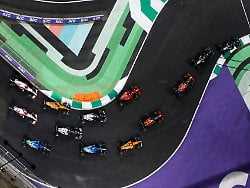Sprint upgraded significantly
Formula 1 changes rules for awarding points
2/14/2022, 6:43 p.m
The sprint remains: Formula 1 will again hold the 100-kilometer race at three Grands Prix next season. There are now significantly more points up for grabs than last year. There are also changes to the pole position and the classification in the event of a cancellation.
Formula 1 will also rely on sprint races in the 2022 season, but will significantly upgrade the format introduced last year. Although there will be three sprints of around 100 kilometers each, significantly more points will be awarded in the future. So far, the top three have been awarded points in descending order (3-2-1), now the top eight (8-7-6-5-4-3-2-1) should be rewarded with something countable for the drivers’ championship. on that according to official announcement the shareholders of Formula 1, the world motorsport association FIA and the ten racing teams agreed.
The sprints are scheduled for the fourth race weekend in Imola (Emilia-Romagna Grand Prix, April 22-24), the eleventh round in Spielberg (Austrian Grand Prix, July 8-10) and the Brazilian Grand Prix (November 11-13) in São Paulo, the penultimate date in the 23-stage calendar for the coming season. On these three weekends, the usual qualifying moves to Friday, the sprint takes place on Saturday, and the race remains on Sunday as usual. Qualifying is decisive for the starting grid in the sprint, the sprint result determines the starting grid for the race.
In the run-up to this decision, there had been speculation that Formula 1 was planning up to six sprints. According to unanimous reports, however, the big teams such as Mercedes, Red Bull and Ferrari in particular resisted this plan. They even called for the upper cost limit to be abolished or at least increased in order to be able to counteract any damage. This has been in effect since last season, when it was $145 million, is fixed at $140 million for 2022 and will drop by another five million for 2023. The announcement of three sprints is therefore to be seen as a compromise.
Different score for abandoned races
Another change to the sprint mode is more statistical in nature, but significant for the pilots. The pole position is now included in the statistics for the fastest in qualifying. Last year, pole was attributed to the sprint winner, which was criticized by drivers, experts and fans alike. Instead, the following now applies to all 23 race weekends: Whoever sets the best time in the last qualifying section gets pole position in the statistics. Also in the event that he loses positions during the sprint and thus starts the race from further behind on Sunday.
There is also a new regulation with regard to the evaluation of canceled Grands Prix. A reaction to the farce of Spa-Francorchamps, where the Belgian Grand Prix was waved off prematurely after two laps behind the safety car due to persistent rain and was still rewarded with half the number of points. This case will be ruled out in the future. Then there must be at least two free and uninterrupted rounds for a rating.
In addition, it gets loud “Motorsport Magazine” Adjusted the distribution of points in the case of cancellations. If less than 25 percent of the race distance is completed, only the top five (6-4-3-2-1) receive points. At 26 to 50 percent of the race distance the top nine (13-10-8-6-5-4-3-2-1), at 50 to 75 percent the top ten (19-14-12-9-8-6 -5-3-2-1). If more than 75 percent of the race distance has been covered at the time the race is stopped, the usual distribution key applies (25-18-15-12-10-8-6-4-2-1). All of these new regulations have yet to be approved by the World Motor Sport Council, but this is considered a formality.
